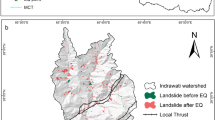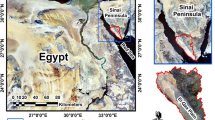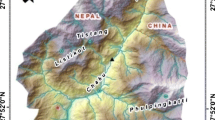Abstract
Nepal was hit by a 7.8 magnitude earthquake on 25th April, 2015. The main shock and many large aftershocks generated a large number of coseismic landslips in central Nepal. We have developed a landslide susceptibility map of the affected region based on the coseismic landslides collected from remotely sensed data and fieldwork, using bivariate statistical model with different landslide causative factors. From the investigation, it is observed that most of the coseismic landslides are independent of previous landslides. Out of 3,716 mapped landslides, we used 80% of them to develop a susceptibility map and the remaining 20% were taken for validating the model. A total of 11 different landslide-influencing parameters were considered. These include slope gradient, slope aspect, plan curvature, elevation, relative relief, Peak Ground Acceleration (PGA), distance from epicenters of the mainshock and major aftershocks, lithology, distance of the landslide from the fault, fold, and drainage line. The success rate of 87.66% and the prediction rate of 86.87% indicate that the model is in good agreement between the developed susceptibility map and the existing landslides data. PGA, lithology, slope angle and elevation have played a major role in triggering the coseismic mass movements. This susceptibility map can be used for relocating the people in the affected regions as well as for future land development.
Similar content being viewed by others
Abbreviations
- HFT:
-
Himalayan Frontal Thrust
- MBT:
-
Main Boundary Thrust
- MCT:
-
Main Central Thrust
- STD:
-
South Tibetan Detachment
- GMA:
-
Great Midland Antiform
- PGA:
-
Peak Ground Acceleration
References
Adhikari LB, Gautam UP, Koirala BP, et. al. (2015) The aftershock sequence of the 2015 April 25 Gorkha–Nepal earthquake. Geophysical Journal International 203: 2119–2124. DOI: 10.1093/gji/ggv412
Alfaro P, Delgado J, García-Tortosa FJ, et. al. (2012) Widespread landslides induced by the Mw 5.1 earthquake of 11 May 2011 in Lorca, SE Spain. Engineering Geology 137-138: 40–52. DOI:10.1016/j.enggeo.2012.04.002
Anbalagan R, Kumar R, Lakshmanan K, et. al. (2015) Landslide hazard zonation mapping using frequency ratio and fuzzy logic approach, a case study of Lachung Valley, Sikkim. Geoenvironmental Disasters 2(1): 1–17. DOI: 10.1186/s40677-014-0009-y
Avouac JP, Tapponnier P (1993) Kinematic model of active deformation in central Asia. Geophysical Research Letters 20(10): 895–898. DOI:10.1029/93GL00128
Bonham-Carter G (1994) Preface. In: Graeme FB-C (ed) Computer Methods in the Geosciences, vol Volume 13. Pergamon, pp xiii–xvii. DOI: 10.1016/B978-0-08-042420-0.50005-5
Cardinali M, Galli M, Guzzetti F, et. al. (2006) Rainfall induced landslides in December 2004 in south-western Umbria, central Italy: types, extent, damage and risk assessment. Natural Hazards and Earth System Sciences 6(2): 237–260. DOI: 10.5194/nhess-6-237-2006
Çevik E, Topal T (2003) GIS-based landslide susceptibility mapping for a problematic segment of the natural gas pipeline, Hendek (Turkey). Environmental Geology 44(8): 949–962. DOI: 10.1007/s00254-003-0838-6
Chen XL, Yu L, Wang MM, et. al. (2014) Brief Communication: Landslides triggered by the Ms = 7.0 Lushan earthquake, China. Natural Hazards and Earth System Sciences 14(5): 1257–1267. DOI: 10.5194/nhess-14-1257-2014
Chigira M, Wu X, Inokuchi T, Wang G (2010) Landslides induced by the 2008 Wenchuan earthquake, Sichuan, China. Geomorphology 118(3-4): 225–238. DOI: 10.1016/j.geomorph. 2010.01.003
Chigira M, Yagi H (2006) Geological and geomorphological characteristics of landslides triggered by the 2004 Mid Niigta prefecture earthquake in Japan. Engineering Geology 82(4): 202–221. DOI: 10.1016/j.enggeo.2005.10.006
Chung CJ, Fabbri A (2003) Validation of Spatial Prediction Models for Landslide Hazard Mapping. Natural Hazards 30(3): 451–472. DOI: 10.1023/B:NHAZ.0000007172.62651.2b
Colchen M, Le Fort P, Pêcher A (1986) Annapurna–Manaslu–Ganesh Himal. Centre National de la Recherches Scientifique, Special Publication, Paris
Collins BD, and Jibson RW (2015) Assessment of existing and potentiallandslide hazards resulting from the April 25, 2015 Gorkha, Nepal earthquakesequence (ver. 1.1, August 2015): U.S. Geological Survey Open-File Report 2015-1142, p. 50. DOI: 10.3133/ofr20151142
Dai FC, Xu C, Yao X, et. al. (2011) Spatial distribution of landslides triggered by the 2008 Ms 8.0 Wenchuan earthquake, China. Journal of Asian Earth Sciences 40: 883–895. DOI: 10.1016/j.jseaes.2010.04.010
Dewey JF, Burke ACA (1973) Tibetan, Variscan, and Precambrian basement reactivation: products of continental collision. The Journal of Geology 81(6): 683–692.
Dhital MR (2015) Geology of the Nepal Himalaya: Regional Perspective of the Classic Collided Orogen (Regional Geology Reviews). Springer; 2015 edition (February 12, 2015).
Douglas J (2003) Earthquake ground motion estimation using strong-motion records: a review of equations for the estimation of peak ground acceleration and response spectral ordinates. Earth-Science Reviews 61(1-2): 43–104. DOI: 10.1016/S0012-8252(02)00112-5
Ercanoglu M, Gokceoglu C (2004) Use of fuzzy relations to produce landslide susceptibility map of a landslide prone area (West Black Sea Region, Turkey). Engineering Geology 75(3-4): 229–250. DOI: 10.1016/j.enggeo.2004.06.001
Gökceoglu C, Aksoy H (1996) Landslide susceptibility mapping of the slopes in the residual soils of the Mengen region (Turkey) by deterministic stability analyses and image processing techniques. Engineering Geology 44(1-4): 147–161. DOI: 10.1016/S0013-7952(97)81260-4
Gorum T, van Westen CJ, Korup O, et. al. (2013) Complex rupture mechanism and topography control symmetry of mass-wasting pattern, 2010 Haiti earthquake. Geomorphology 184: 127–138. DOI: 10.1016/j.geomorph. 2012.11.027
Guzzetti F, Carrara A, Cardinali M, Reichenbach P (1999) Landslide hazard evaluation: a review of current techniques and their application in a multi-scale study, Central Italy. Geomorphology 31(1-4): 181–216. DOI: 10.1016/S0169-555X (99)00078-1
Guzzetti F, Mondini AC, Cardinali M, et. al. (2012) Landslide inventory maps: New tools for an old problem. Earth-Science Reviews 112(1-2): 42–66. DOI: 10.1016/j.earscirev.2012.02.001
Guzzetti F, Reichenbach P, Cardinali M, et. al. (2005) Probabilistic landslide hazard assessment at the basin scale. Geomorphology 72(1-4): 272–299. DOI: 10.1016/j.geomorph.2005.06.002
Hagen T (1969) Report on the geological survey of Nepal. Volume 1: Preliminary Reconnaissance. Denkschiiften der Schweizerischen Naturforschenden Gesellschaft, Band LXXXVI/1, p. 185. (with ageological map)
Harp EL, Jibson RW (1996) Landslides triggered by the 1994 Northridge, California, earthquake. Bulletin of the Seismological Society of America 86(1 Suppl. B).
Harp EL, Keefer DK, Sato HP, et al. (2011) Landslide inventories: The essential part of seismic landslide hazard analyses. Engineering Geology 122(1-2): 9–21. DOI: 10.1016/j. enggeo.2010.06.013
Huang RQ, Li WL (2013) Co-Seismic Fault Effects of Landslides Triggered by Wenchuan Ms 8.0 Earthquake, China. In: Huang Y, Wu F, Shi Z, et al. (eds.), New Frontiers in Engineering Geology and the Environment. Springer Berlin Heidelberg. pp 1–11
Jadda M, Shafri HZM, Mansor SB, et. al. (2009) Landslide susceptibility evaluation and factor effect analysis usingprobabilistic-frequency ratio model. European Journal of Scientific Research 33(4): 654–668.
Kargel JS, Leonard GJ, Shugar DH, et. al. (2016) Geomorphic and geologic controls of geohazards induced by Nepal’s 2015 Gorkha earthquake. Science 351(6269): aac8353. DOI: 10.1126/science.aac8353
Kayastha P (2015) Landslide susceptibility mapping and factor effect analysis using frequency ratio in a catchment scale: a case study from Garuwa sub-basin, East Nepal. Arabian Journal of Geosciences 8: 8601–8613. DOI: 10.1007/s12517-015-1831-6
Keefer DK (1984) Landslides caused by earthquakes. Geological Society of America Bulletin 95(4): 406–421.
Keefer DK (2002) Investigating landslides caused by earthquakes—a historical review. Surveys in Geophysics 23(6): 473–510. DOI: 10.1023/A:1021274710840
Khazai B, Sitar N (2004) Evaluation of factors controlling earthquake-induced landslides caused by Chi-Chi earthquake and comparison with the Northridge and Loma Prieta events. Engineering Geology 71(1-2): 79–95. DOI: 10.1016/S0013-7952(03)00127-3
Lee CT, Huang CC, Lee JF, et. al. (2008) Statistical approach to earthquake-induced landslide susceptibility. Engineering Geology 100(1-2): 43–58. DOI: 10.1016/j.enggeo.2008.03.004
Martha TR, Kerle N, van Westen CJ, et. al. (2012) Objectoriented analysis of multi-temporal panchromatic images for creation of historical landslide inventories. ISPRS Journal of Photogrammetry and Remote Sensing 67: 105–119. DOI: 10.1016/j.isprsjprs.2011.11.004
Ministry of Home Affairs (MoHA), Government of Nepal (2015) Available online at: http://www.moha.gov.np/
Oh HJ, Lee S (2011) Landslide susceptibility mapping on Panaon Island, Philippines using a geographic information system. Environmental Earth Sciences 62(5): 935–951. DOI: 10.1007/s12665-010-0579-2
Owen LA, Kamp U, Khattak GA, et. al. (2008) Landslides triggered by the 8 October 2005 Kashmir earthquake. Geomorphology 94(1-2): 1–9. DOI: 10.1016/j.geomorph. 2007.04.007
Ozdemir A, Altural T (2013) A comparative study of frequency ratio, weights of evidence and logistic regression methods for landslide susceptibility mapping: Sultan Mountains, SW Turkey. Journal of Asian Earth Sciences 64: 180–197. DOI: 10.1016/j.jseaes.2012.12.014
Poudyal C, Chang C, Oh H-J, et al. (2010) Landslide susceptibility maps comparing frequency ratio and artificial neural networks: a case study from the Nepal Himalaya. Environmental Earth Sciences 61(5): 1049–1064. DOI: 10.1007/s12665-009-0426-5
Pradhan B, Lee S (2010) Delineation of landslide hazard areas on Penang Island, Malaysia, by using frequency ratio, logistic regression, and artificial neural network models. Environmental Earth Sciences 60(5): 1037–1054. DOI: 10.1007/s12665-009-0245-8
Qi S, Xu Q, Lan H, et. al. (2010) Spatial distribution analysis of landslides triggered by 2008.5.12 Wenchuan Earthquake, China. Engineering Geology 116(1-2): 95–108. DOI: 10.1016/j. enggeo.2010.07.011
Regmi A, Yoshida K, Pourghasemi H, et. al. (2014) Landslide susceptibility mapping along Bhalubang — Shiwapur area of mid-Western Nepal using frequency ratio and conditional probability models. Journal of Mountain Science 11(5): 1266–1285. DOI: 10.1007/s11629-013-2847-6
Regmi AD, Cui P, Dhital MR, Zou Q (2016) Rock fall hazard and risk assessment along Araniko Highway, Central Nepal Himalaya. Environmental Earth Sciences 75: 1–20. DOI: 10.1007/s12665-016-5905-x
Ren Z, Lin A (2010) Co-seismic landslides induced by the 2008 Wenchuan magnitude 8.0 Earthquake, as revealed by ALOS PRISM and AVNIR2 imagery data. International Journal of Remote Sensing 31: 3479–3493. DOI: 10.1080/014311610037 27770
Reneau SL, Dietrich WE (1987) The importance of hollows in debris flow studies; Examples from Marin County, California. In: Costa JE, Wieczorek GF (eds.), Debris Flows/Avalanches: Process, Recognition, and Mitigation. Geological Society of America, Boulder, Colorado. Reviews in Engineering Geology VII: 165–180. DOI: 10.1130/REG7-p165
Sato H, Hasegawa H, Fujiwara S, et. al. (2007) Interpretation of landslide distribution triggered by the 2005 Northern Pakistan earthquake using SPOT 5 imagery. Landslides 4(2): 113–122. DOI: 10.1007/s10346-006-0069-5
Sato H, Sekiguchi T, Kojiroi R, et. al. (2005) Overlaying landslides distribution on the earthquake source, geological and topographical data: the Mid Niigata prefecture earthquake in 2004, Japan. Landslides 2(2): 143–152. DOI: 10.1007/s10346-005-0053-5
Shahabi H, Khezri S, Ahmad BB, Hashim M (2014) Landslide susceptibility mapping at central Zab basin, Iran: A comparison between analytical hierarchy process, frequency ratio and logistic regression models. CATENA 115: 55–70. DOI: 10.1016/j.catena.2013.11.014
Shafique M, van der Meijde M, Khan MA (2016) A review of the 2005 Kashmir earthquake-induced landslides; from a remote sensing prospective. Journal of Asian Earth Sciences 118: 68–80. DOI: 10.1016/j.jseaes.2016.01.002
Stocklin J (1980) Geology of Nepal and its regional frame: Thirty-third William Smith Lecture. Journal of the Geological Society 137(1): 1–34. DOI:10.1144/gsjgs.137.1.0001
U.S. Geological Survey, Earthquake Hazards Program (2015) Available online at: http://earthquake.usgs.gov (Accessed on 20 May 2015)
van Westen CJ, Castellanos E, Kuriakose SL (2008) Spatial data for landslide susceptibility, hazard, and vulnerability assessment: An overview. Engineering Geology 102(3-4): 112–131. DOI: 10.1016/j.enggeo.2008.03.010
Wang HB, Sassa K, Xu WY (2007) Analysis of a spatial distribution of landslides triggered by the 2004 Chuetsu earthquakes of Niigata Prefecture, Japan. Natural Hazards 41(1): 43–60. DOI: 10.1007/s11069-006-9009-x
Wang LJ, Guo M, Sawada K, et. al. (2015) A comparative study of landslide susceptibility maps using logistic regression, frequency ratio, decision tree, weights of evidence and artificial neural network. Geosciences Journal 20(1): 117–136. DOI: 10.1007/s12303-015-0026-1
Wartman J, Dunham L, Tiwari B, et al. (2013) Landslides in eastern Honshu induced by the 2011 off the Pacific coast of Tohoku Earthquake. Bulletin of the Seismological Society of America 103(2B): 1503–1521.
Xu C, Xu X, Yao X, Dai F (2013) Three (nearly) complete inventories of landslides triggered by the May 12, 2008 Wenchuan Mw 7.9 earthquake of China and their spatial distribution statistical analysis. Landslides 11: 441–461. DOI: 10.1007/s10346-013-0404-6
Xu C, Xu X, Shyu JBH (2015) Database and spatial distribution of landslides triggered by the Lushan, China Mw 6.6 earthquake of 20 April 2013. Geomorphology 248: 77–92. DOI: 10.1016/j.geomorph.2015.07.002
Yagi H, Sato G, Higaki D, et. al. (2009) Distribution and characteristics of landslides induced by the Iwate–Miyagi Nairiku Earthquake in 2008 in Tohoku District, Northeast Japan. Landslides 6(4): 335–344. DOI:10.1007/s10346-009-0182-3
Yalcin A (2008) GIS-based landslide susceptibility mapping using analytical hierarchy process and bivariate statistics in Ardesen (Turkey): Comparisons of results and confirmations. CATENA 72(1): 1–12. DOI: 10.1016/j.catena. 2007.01.003
Yamagishi H, Iwahashi J (2007) Comparison between the two triggered landslides in Mid-Niigata, Japan by July 13 heavy rainfall and October 23 intensive earthquakes in 2004. Landslides 4(4): 389–397. DOI:10.1007/s10346-007-0093-0
Yin Y, Wang F, Sun P (2009) Landslide hazards triggered by the 2008 Wenchuan earthquake, Sichuan, China. Landslides 6(2): 139–152. DOI:10.1007/s10346-009-0148-5
Author information
Authors and Affiliations
Corresponding author
Additional information
http://orcid.org/0000-0002-1423-9990
http://orcid.org/0000-0002-8093-7658
http://orcid.org/0000-0003-3908-1082
http://orcid.org/0000-0001-9972-4698
http://orcid.org/0000-0002-0177-0811
Electronic supplementary material
Rights and permissions
About this article
Cite this article
Regmi, A.D., Dhital, M.R., Zhang, Jq. et al. Landslide susceptibility assessment of the region affected by the 25 April 2015 Gorkha earthquake of Nepal. J. Mt. Sci. 13, 1941–1957 (2016). https://doi.org/10.1007/s11629-015-3688-2
Received:
Accepted:
Published:
Issue Date:
DOI: https://doi.org/10.1007/s11629-015-3688-2




